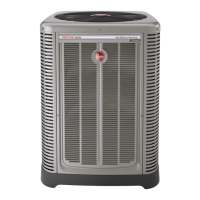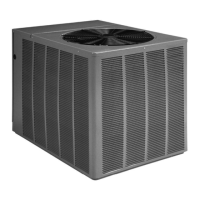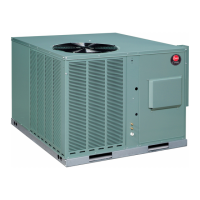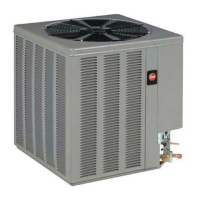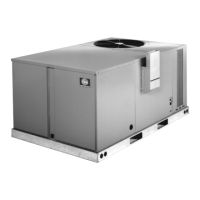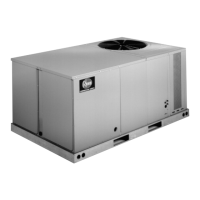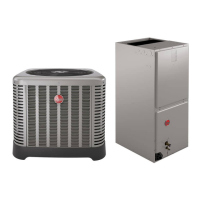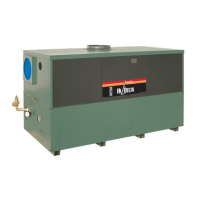31
Operation
between the temperature set-point and the room
temperature measured at the Control Center. One
second after the compressor starts, the VSODC
will direct the variable speed ECM outdoor motor
to operate at the appropriate speed to deliver
the necessary outdoor air-flow for that capacity
percentage. Upon a call for heating, the EcoNet
TM
Control Center accesses the indoor air-flow
parameters found in the model data residing in the
VSODC memory card and directs the EcoNet
TM
enabled air-handler or gas furnace control board to
deliver an appropriate indoor air-flow level based
on the capacity percentage required at that point
in time. The EcoNet
TM
air-handler or gas furnace
control board will then direct the variable speed
ECM indoor blower motor to start and operate
at the requested heating air-flow level. As the
building load changes throughout the call for
heating operation, the compressor speed, outdoor
fan speed, and indoor air-flow level will respond
by ramping up or down as required to meet the
building load exactly rather than simply cycling
on and off as conventional systems do. Since the
noise level of the compressor increases as speed
increases, the maximum allowable compressor
speed in the Overdrive Mode can be lowered
using the EcoNet
TM
Control Center Installer Menu
(RPM Blocking) should the homeowner find the
compressor noise objectionable in the Overdrive
Mode. The current compressor RPM can also be
viewed in the EcoNet
TM
Control Center Service
Menu. When the call for heating has ended, the
EcoNet
TM
Control Center will direct the outdoor
and indoor units to shut down. The compressor
and outdoor fan motor will ramp down to zero
RPM and the indoor blower motor will ramp down
to the minimum air-flow level for 30-45 seconds to
extract the residual heating from the cold indoor
coil before it stops.
6.5 Supplemental Electric
Heat in Heating Mode
If the building load should exceed the heating
capacity in extreme outdoor conditions, the
EcoNet
TM
Control Center will direct the RHMV air-
handler to energize supplemental electric heat as
required to meet the building load. The indoor air-
flow will be forced to operate at the maximum level
for the system. For 13kW heaters and higher, the
supplemental electric heat will be energized in two
stages as required. The compressor and outdoor
fan will continue to operate at maximum capacity
while supplemental electric heat is energized.
6.6 Dual Fuel Applications
– Heating Mode
If the building load should exceed the heat pump
heating capacity in extreme outdoor conditions,
the EcoNet
TM
Control Center will direct the outdoor
unit to shut down and heating responsibility
will be transferred to the gas furnace. An
outdoor ambient temperature can be set in the
EcoNet
TM
Control Center to direct the system to
automatically switch to gas heat when the outdoor
ambient temperature drops below that set-
point. If the EcoNet
TM
Control Center is set to the
EMERGENCY HEAT (Furnace Only) mode, heating
responsibility will be transferred to the gas furnace.
6.7 Demand Defrost
Defrosting of the outdoor coil in the heating mode
is controlled by the Variable Speed Outdoor
Control (VSODC). (-)P20 heat pumps utilizes
“demand defrost” that initiates a defrost cycle
only when frosting is detected on the outdoor
coil during heating operation. The VSODC
continuously monitors the Outdoor Ambient
Temperature Thermistor (OAT) and Outdoor Coil
Temperature Thermistor (EVAPIN) to determine
when a defrost cycle is required. The following
sequence is followed for defrost cycles.
• Defrost Initiation: A defrost cycle is initiated
when the following conditions are met.
1. The outdoor coil temperature is below 35°F
[1.7°C].
2. The compressor has operated for at least
34 minutes with the outdoor coil
temperature below 35°F [1.7°C].
3. The VSODC determines a defrost cycle
is required based on the OAT and EVAPIN
temperatures.
If the above conditions are met, the following
action will be taken.
1. The compressor speed is ramped to the
predetermined reversing valve switching
speed for 30 seconds before the reversing
valve is de-energized.
2. The reversing valve is de-energized which
will cause it to shift to the cooling position.
3. The outdoor EXV is driven to the 100%
open position.
4. The outdoor fan motor is de-energized.
6.0 NORMAL SEQUENCE OF OPERATION
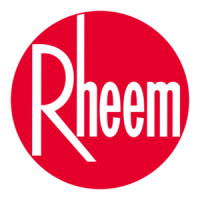
